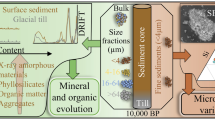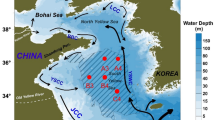Abstract
MUCH effort has been directed at measuring concentration gradients at the sediment/water interface of aquatic systems, where the biogeochemical cycling of natural and pollutant species is particularly active1. Precise measurements of oxygen gradients using microelectrodes2 and estimates from independently determined fluxes3 suggest that concentration gradients in this region often extend only to depths of ˜1 mm, much less than the resolution (˜1 centimetre) of conventional techniques4–7. We have developed a new method for measuring pore-water composition in which diffusive equilibrium is established rapidly (within minutes) in a thin film of gel inserted in the sediment. On removal, the dissolved components are fixed, allowing chemical measurements to be made at high spatial resolution (<1 mm) on a stable solid phase. Using MeV-proton-induced X-ray emission (PIXE) to analyse the dried gel, we have measured iron concentrations in lacustrine pore waters at submillimetre resolution, revealing steep concentration gradients and sub-surface maxima consistent with a hypothesis of localized, reductive dissolution of fresh material.
Similar content being viewed by others
References
Santschi, P., Hohener, P., Benoit, G. & Buchholtz-ten Brink, M. Mat. Chem. 30, 269–315 (1990).
Gunderson, J. K. & Jorgensen, B. B. Nature 345, 604–607 (1990).
Davison, W. in Chemical Processes in Lakes (ed. Stumm, W.) (Wiley, New York, 1985).
Davison, W., Woof, C. & Turner, D. R. Nature 295, 582–583 (1982).
Carignan, R., Rapin, F. & Tessier, A. Geochim. cosmochim. Acta 49, 2493–2499 (1985).
Mayer, L. M. Limnol. Oceanogr. 21, 909–912 (1976).
Hesslein, R. H. Limnol. Oceanogr. 21, 912–914 (1976).
Hamilton-Taylor, J. & Morris, E. B. Arch. Hydrobiol. 72, 135–165 (1985).
Belzile, N., DeVitre, R. R. & Tessier, A. Nature 340, 376–377 (1989).
Laemmli, U. K. Nature 227, 680–685 (1970).
Millero, F. J., Sotolongo, S. & Izaguirre, M. Geochim. cosmochim. Acta 51, 793–801 (1987).
Johanson, S. A. E. & Campbell, J. L. PIXE—A Novel Technique for Elemental Analysis (Wiley, New York, 1988).
Watt, F. & Grime, G. W. (eds) Principles and Applications of High Energy Microbeams (Hilger, Bristol. 1987).
Grime, G. W., Dawson, M., Marsh, M., McArthur, I. C. & Watt, F. Nucl. Instrum. Meth. B54, 52–63 (1991).
Mortimer, C. H. Limnol. Oceanogr. 16, 387–404 (1971).
Heaney, S. I., Smyly, W. J. P. & Tailing, J. F. Int. Rev. ges. Hydrobiol. 71, 441–494 (1986).
Ramsbottom, A. E. Sclent Publ. Freshwater Biol. Assoc. 33, 10–13 (1976).
Davison, W., Woof, C. & Rigg, E. Limnol. Oceanogr. 27, 987–1003 (1982).
Davison, W. Nature 290, 241–243 (1981).
Author information
Authors and Affiliations
Rights and permissions
About this article
Cite this article
Davison, W., Grime, G., Morgan, J. et al. Distribution of dissolved iron in sediment pore waters at submillimetre resolution. Nature 352, 323–325 (1991). https://doi.org/10.1038/352323a0
Received:
Accepted:
Issue Date:
DOI: https://doi.org/10.1038/352323a0
- Springer Nature Limited
This article is cited by
-
Diffusive gradients in thin films: devices, materials and applications
Environmental Chemistry Letters (2019)
-
High-resolution profiles of iron, manganese, cobalt, cadmium, copper and zinc in the pore water of estuarine sediment
International Journal of Environmental Science and Technology (2013)
-
Application of DET (diffusive equilibrium in thin films) and DGT (diffusive gradients in thin films) techniques in the study of the mobility of sediment-bound metals in the outer section of Songkhla Lake, Southern Thailand
Environmental Monitoring and Assessment (2013)
-
Seasonal phosphorus dynamics in the surficial sediment of two shallow temperate lakes: a solid-phase and pore-water study
Hydrobiologia (2013)
-
Determination of High Resolution Pore Water Profiles of Trace Metals in Sediments of the Rupel River (Belgium) using Det (Diffusive Equilibrium in Thin Films) and DGT (Diffusive Gradients in Thin Films) Techniques
Water, Air, and Soil Pollution (2005)





